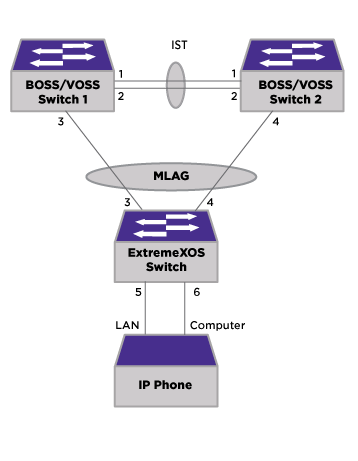Using Simple Loop Prevention Protocol (SLPP) Guard
Simple Loop Prevention Protocol (SLPP) is an application that detects loops in an MLAG or Split Multi-link Trunking (SMLT) network on VOSS/BOSS switches.

Note
When SLPP Guard disables a port, the disabled status is not persistent. If the switch reboots, the port is enabled when the switch comes back up.
Note
If you use the CLI to enable or disable a port that has been disabled by SLPP Guard, the port is enabled or disabled as applicable and the recovery timer is stopped for that port.When a new user is authenticated by netlogin, the enable attribute of SLPP Guard is given to netlogin. Netlogin processes this attribute and sends the enable attribute message to the SLPP Guard module. If all users are unauthenticated by netlogin, a disable message for the port is sent to SLPP Guard. At the time of re-authentication, if the FA-Service-Request = SLPPGUARD is removed from the RADIUS server, then netlogin sends an SLPP Guard disable message.

Note
If you modify the RADIUS attributes in between authentication, then a port restart or clear all netlogin clients is required in order for the service attributes to change on the port.The status is enabled and the entry in the save configuration command is sent to enable slpp guard port port_list for the following scenarios:
- If the status of SLPP Guard is enabled by the CLI.
- If the status of SLPP Guard is enabled by both the Vendor Specific Attribute (VSA) and by the CLI.
- If after enabling SLPP Guard by the CLI, the status is then disabled from the VSA.
The status is enabled and the saved configuration contains default values for the following scenarios:
- If the status of SLPP Guard is enabled by the VSA.
- If after enabling SLPP Guard by the VSA, the status is then disabled from the CLI.

Supported Platforms
All ExtremeSwitching switches.
Limitations
- SNMP for SLPP Guard is not supported.
- The SLPP Guard active state per port is limited by the number of available ACL filters.

